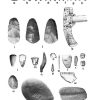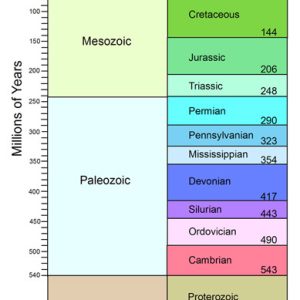calsfoundation@cals.org
Fossils
Fossils are the remains of animals and plants that have been preserved in the earth’s crust. They can consist of the remains of invertebrates (animals without a backbone) or vertebrates (animals with a backbone). The majority of fossils in the fossil record, and from Arkansas, are invertebrate remains.
Fossils are found mostly in sedimentary rocks, as compared to igneous and metamorphic rocks, and can form in a variety of ways. Animals living in the water column in the ocean die, and their shells or hard parts sink to the bottom of the seafloor and become preserved in sediments that later may lithify, or change to rock. Other animals crawl on the seafloor through sand and silt or burrow into the seafloor and leave tracks, trails, and imprints that are later preserved as trace fossils. Land plants and animals are preserved in a similar manner when they die. If the animal or plant is buried rather quickly, then a more complete fossil may be preserved; however, if the animal or plant is weathered by the elements such as wind or water, then most of the potential fossil could be lost, leaving only fragments in the fossil record. Only a very small percentage of living organisms ever become fossilized.
Fossils are important to scientists because they can be used to date the rocks in which they occur. Rocks of the same age contain similar fossils even when the rock formations extend over large areas—from state to state or continent to continent. There is also a distinct succession of fossils from oldest to youngest throughout geologic time. Using these concepts, geologists correlate rocks containing the same types of fossils from different areas throughout the world. The general principle is called the Law of Fossil Succession. When one particular type of fossil is dominant in a rock unit and used to date the rock formations representing that period, the fossil is called an index fossil. An index fossil must be 1) easily recognized and distinguished from other fossils, 2) geographically widespread, 3) restricted in time, and 4) present in many kinds of sedimentary rocks so they can be found in many places. Ammonoids, conodonts, and foraminifers are found in rocks in Arkansas and are used as index fossils.
Fossils also give clues to the environment in which they lived. When fossils of marine organisms are found within a rock, one must conclude that the area was once covered by a shallow sea that supported animal life. Marine fossils found in Arkansas indicate that throughout geologic time portions of Arkansas were covered by warm, shallow seas. Likewise, when fossils from animals that lived on land are found, scientists must conclude that the area was above sea level at that time. Plant and tree-like fossils found in Arkansas indicate that areas in the state were once covered by swamps and areas of higher ground containing small forests.
Arkansas has fossils from all of the major fossil groups; however, the most commonly collected fossils are echinoderms, mollusks, brachiopods, bryozoans, and cnidarians (corals and jellyfish). Less frequently recovered are chordate fossils (bones), including dinosaur remains.
Different types of fossils are present in each of the physiographic provinces of Arkansas. The majority of fossils in Arkansas are present in limestone and shale from the Ozark Plateau Region in the northern portion of the state. Most of the rocks in this portion of the state formed in shallow seas where marine invertebrate animals thrived. The most abundant fossil from this region is the crinoid, although other notable fossils include ammonoids, nautiloids, trilobites, and stromatolites. The Arkansas River Valley does not contain the variety of marine fossils present in the Ozarks; however, trace fossils and plant or tree fossils do occur. The least number of fossils is found in the Ouachita Mountains, principally because the environment in which the rocks formed was not a setting where most marine animals could live. Graptolites and trace fossils are practically the only macro fossils found in the Ouachitas. The West Gulf Coastal Plain is mostly non-fossiliferous except for its western portion, where Cretaceous-age rocks outcrop at the surface. As can be expected, this is the only part of the state where dinosaur remains can be found. Other popular fossils from this region include remains from vertebrates such as sharks and marine reptiles. Invertebrate remains include oyster shells, clams, and snails. Since the Mississippi River Alluvial Plain consists mostly of recent unconsolidated sediments, the likelihood of finding fossils in this region is very slight. However, remains from large mammals such as mammoths, mastodons, dire wolves, and saber-toothed cats have been found in this part of the state. Other notable fossils from this region include petrified wood fragments, shark teeth, and oyster beds in the outcrops along Crowley’s Ridge.
For additional information:
Arkansas Geological Survey. https://www.geology.arkansas.gov/ (accessed April 5, 2022).
Pittman, Jeffery G., and David D. Gillette. “The Briar Site: A New Sauropod Tracksite in Lower Cretaceous Beds of Arkansas.” In Dinosaur Tracks and Traces, edited by David D. Gillette and Martin G. Lockley. Cambridge: Cambridge University Press, 1989.
———. “Tracking the Arkansas Dinosaurs.” Special issue, The Arkansas Naturalist 2 (March 1984).
Thompson, Ida, and Townsend P. Dickinson. National Audubon Society Field Guide to North American Fossils. New York: Knopf, 1982.
Angela Chandler
Arkansas Geological Survey
 Pre-European Exploration, Prehistory through 1540
Pre-European Exploration, Prehistory through 1540 Geologic Time Scale
Geologic Time Scale  Physiographic Regions
Physiographic Regions 




Comments
No comments on this entry yet.